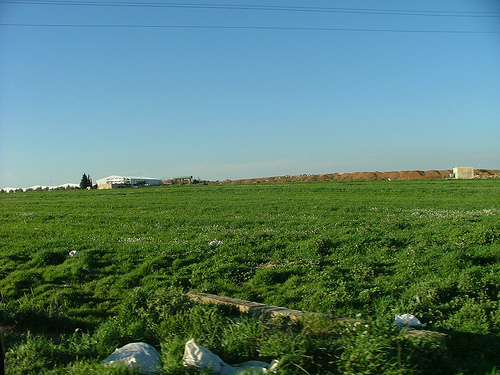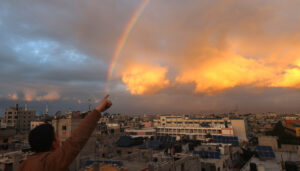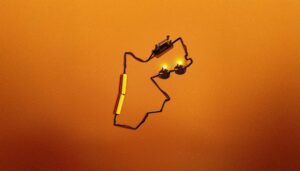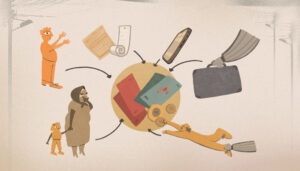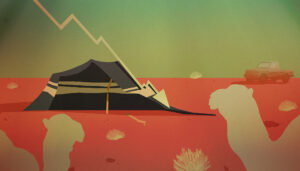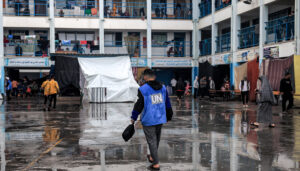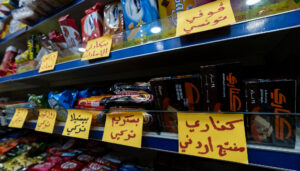Fish Farming and Techie Refugees: Jordan’s Development Mysteries
Written by Hisham A. Kassim*
Malcolm Gladwell wrote an article differentiating mysteries from puzzles.[1] One is a problem of too much information and the other too little. Once you know a critical piece of information the puzzle is solved. Mysteries need someone to sift through the information to find the relevant pieces. I argue that Jordan’s development problem is a mystery and not a puzzle. We have more than enough information to solve it but just need a new way of looking at it.
Comparative politics tries to explain why one country looks the way it does versus another. Ideally you would start with two countries that have a lot in common. For example, Haiti and the Dominican Republic are located on the same island, are about the same size, have similar histories, and culturally about the same. However, one is a democracy and the other is not.[2] One has a GDP per capita of $1,300 the other six times that at $8,200.[3] What accounts for this difference? It’s not the language, historical context, geography, or natural resources because both countries are the same in these respects. There must be another variable at work here.
Some have attributed the difference between these two countries to land distribution – one country had a feudal type of land system with a few landowners and a large underclass of peasants while the other was based on small family farms. The argument goes, feudal lords are anti-democratic because if elections are held, peasants will vote for land reform.[4] There is some merit to this argument and if it is correct, than the path to democracy and prosperity is pretty straightforward – land reform. Give every family a small farm, some basic government services and let time and human ingenuity do the rest.
This is precisely the type of exercise development experts from the World Bank, International Monetary Fund, and other donor agencies do. They look at what worked in other countries (mostly rich) and implement them in poorer ones. However, as Easterly argues in his books The White Man’s Burden and The Elusive Quest for Growth, most fail and Jordan is no exception. The reasons for failure are too many to list here but in essence it’s a question of incentives. The question remains – how do we solve it? The answer may be in the reason why one country, like Haiti, developed a feudal land system and the Dominican Republic small family farms.
Jordan is a developing country with little water and a GDP per capita (in real terms) lower than Egypt’s.[5] Unemployment hovers at 30% and half the population is under the age of 24.[6] Jordan also suffers from severe brain drain with approximately 600,000 of its most skilled workers living outside the country[7] representing a third of the workforce. Only 3.5% of the country is arable with the rest being desert. The public sector employs roughly half of all employees – or roughly 800,000 Jordanians.[8] Most of these employees live off less than $300 per month. It’s education system ranks one of the lowest in the world.[9]
Despite the poverty and high unemployment, Jordan still manages to import 400,000 foreign workers (both male Egyptians for manual labor and female south Asians as domestic workers).[10] Foreign workers represent about a third of the country’s workforce. Although Amman did not make the top fifty most expensive places to live it beat cities like Boston and Seattle in the cost-of-living index.[11] Does this mean that income distribution is heavily skewed with a few very rich households held up by an underclass of poor? That’s not a simple answer either. Jordan’s Gini Index is lower than the United States but higher than Egypt’s.[12]
The answer to Jordan’s development mystery may lie in how we solve specific problems facing the country. Let’s look at a universal issue facing all Jordanians – water shortage.[13] Many presume that a large part of Jordan’s development problems stems from the fact that we don’t have enough of it. We cannot farm, we cannot build factories, and we do not have enough water to drink. We ration it to two times a week, are building a pipe from Al Disi in the south to Amman, and now thinking of building a desalination plant in Aqaba.
Let’s look at what other countries have done with the disadvantage of not having enough water. The Negev desert has about the same rainfall as Jordan but has a $40 billion a year industry[14] – more than Jordan’s entire GDP (Israel and Jordan have about the same number of people but Israel’s GDP is six times the size of Jordan’s).[15] The same industry is found in New Mexico and Arizona. Both states have similar rainfall to Jordan.
Those places have taken their seeming disadvantage (lack of water) and turned it into a massive industry – fish and shrimp farming. It seems unlikely but brackish water found in the desert and long exposure to sunlight are ideal conditions to growing fish and shrimp. The water used to grow the fish is so rich in organic matter that it is used to irrigate farms without needing to add any additional fertilizer. Israel is now one of the major suppliers of frozen shrimp to Europe.[16]
To take another example from Israel; when the Soviet Union collapsed in 1989 thousands of Russian Jews immigrated to Israel. Some of them were highly educated engineers and the Israeli government played a part to help them create Silicon Valley’s main competitor – Silicon Wadi.[17] When Iraq invaded Kuwait a year later, Palestinians with similar if not better education levels than their Soviet Jewish counterparts returned to Jordan. The net result – higher real estate prices and higher unemployment. Most of the Jordanians who returned from Kuwait found Jordan unbearable and left back to the Gulf or on to North America. Another missed opportunity for Jordan.
I argue that the problem with Jordan’s development mystery is not solely attributable to the country’s circumstances as is the conventional thinking among political scientists and development experts. Discovering oil, being under occupation, or having good soil and ample rainfall pushes a country along a certain development path. However, what we do with these circumstances is the other half of the problem. For example, take Libya and the UAE. Both oil rich countries and were under colonial rule. Both are Arab and both Muslim. The differences between them are staggering in terms of standard of living and economic development.
Jordan has its share of setbacks but nothing so severe and out of the ordinary that explains this result. In fact we have a few advantages many other developing countries do not. Our neighbors to the East happen to sit on the world’s major oil reserves and are sympathetic to Jordan’s position. Before the first Gulf War Iraq supplied a good part of Jordan’s oil needs for free or at deep discounts.[18] Kuwait and other Gulf countries used to remit large sums of money to the government in aid. Israel is the largest aid recipient of U.S. assistance but Jordan is not too far off. In 2009, U.S. assistance to Israel amounted to $2.5 billion followed by Egypt at $1.6 billion and Jordan at $880 million. Algeria on the other hand received $1.7 million in aid.[19] On a per capita basis, Jordan is the second highest recipient of foreign aid from the U.S. Aid in 2009 amounted to $145 per Jordanian and on a per household basis $550 – just a little less than two month’s salary. In Egypt, U.S. assistance amounted to $2.28 per person.
These figures do not even count funding from the European Union and other donor countries. We have some of the world’s wealthiest patron’s on our side. That we have not done much with that is our fault.
One missed opportunity is random but consistently missing them is unfortunate and implementing disastrous policies is something more – a pattern. Jordan has consistently failed in almost every major realm of life – socially, economically, and politically. It’s true that Jordan is better off than many countries around the world but why should we be satisfied with that. Why can’t we, as some have said, make our desert bloom?
* Hisham A. Kassim is an attorney based in Amman, Jordan and can be reached at [email protected].
[1] See Gladwell, Malcolm. “Open Secrets: Enron, Intelligence, and the Perils of Too Much Information.“ What the Dog Saw: And Other Adventures. Hachette Book Group: New York, 2009.
[2] Lyons, Linda. “Island Divide: Haiti vs. the Dominican Republic.” Accessed March 23, 2010 at http://www.gallup.com/poll/26614/island-divide-haiti-vs-dominican-republic.aspx.
[3] CIA World Fact Book. Accessed March 23, 2010 at https://www.cia.gov/library/publications/the-world-factbook (hereinafter “CIA World Fact Book”).
[4] See Moore, Barrington. Social Origins of Dictatorships and Democracy: Lord and Peseant in the Making of the Modern World. Beacon Press: Boston, 1993.
[5] CIA World Fact Book.
[6] Id.
[7] Ghazal, Mohammad. “Rising cost of living might fuel brain drain – economists.” The Jordan Times. January 18, 2008. Accessed March 23, 2010 at http://www.jordantimes.com/?news=5097.
[8] Al-Kayed, Zuhair. Case Studies in Best Practices in Civil Service Reform for Sustainable Human Development. Working Paper. Accessed March 23, 2010 at http://mirror.undp.org/magnet/Docs/psreform/jordan_ten_best.htm.
[9] “Education in the Arab World.” The Economist. October 15, 2009.
[10] “On the occasion of the World Day for Migrant Workers (Foreign Employees).” Jordan Labor Watch. Phoenix Center for Economic and Informatics Studies. December 21, 2009. Accessed March 23, 2010 at www.labor-watch.net/…/press_release_on_migrantss_workers_in_jordan.pdf.
[11] “World’s most and least expensive cities.” Mercer Human Resource Consulting, 2004 Cost-of-Living Survey. Accessed March 23, 2010 at http://money.cnn.com/pf/features/popups/costofliving/popup.html
[12] CIA World Fact Book. The Gini Index measures the income distribution of a particular country. The lower the number the more evenly wealth is distributed.
[13] Jordan is the fourth poorest water county in the world. Namrouqa, Hana. “Lack of funding, governance compound Kingdom’s water woes.” The Jordan Times. June 8, 2009. Accessed March 23, 2010 at http://www.jordantimes.com/index.php?news=17343.
[14] “Israelis helping to perfect fish farming in the desert.” Israel 21c. Accessed March 23, 2010 at http://www.israel21c.org/social-action/israelis-helping-to-perfect-fish-farming-in-the-desert see also Kraft, Dina. “From Far Beneath the Israeli Desert, Water Sustains a Fertile Enterprise.” The New York Times. January 2, 2007. Accessed March 23, 2010 at http://www.nytimes.com/2007/01/02/science/02fish.html?pagewanted=1&_r=1.
[15] CIA World Fact Book.
[16] Supra Footnote 14.
[17] See Fontenay, Catherine and Erran Carmel. “Israel’s Silicon Wadi: The forces behind cluster formation.” Working Paper. Accessed March 23, 2010 at www.mbs.edu/home/defontenay/IsraelSiliconWadiJune2002.pdf.
[18] Bar’el, Zvi. “The Jordanian dilemma: Who to support?” Haaretz. Accessed March 23, 2010 at http://www.haaretz.com/hasen/pages/ShArtWar.jhtml?itemNo=275265&contrassID=33&subContrassID=4&sbSubContrassID=0.
[19] Sharp, Jeremy. “U.S. Foreign Assistance to the Middle East: Historical Background, Recent Trends, and the FY2010 Request.” Congressional Research Service. July 17, 2009.
